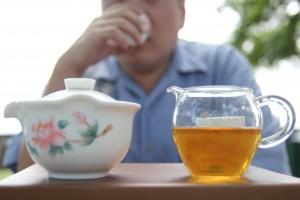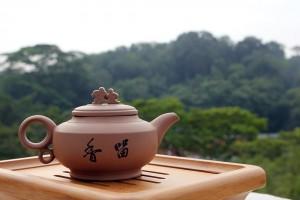The title probably might have some self-professed purist up in arms.
“What? Of course it’s about taste. Most importantly- taste, taste, taste.”
Rest assured this post does not set out to convince you to drink for health reasons alone or that we Asian types are only concerned about the appearance of the leaf but not its gastronomic value. Rather it is about expanding the definition of taste in tea tasting.
What does taste mean to you?
Though no poll has been conducted on this, it would be a reasonable assumption that taste- at least in the context of tea specifically- would refer to identifying the flavors associated with the brewed tea, or the ‘tea soup’ if we take a literal translation of the Chinese term 茶汤 .

‘A clover infused with Merlot and a dash of ’92 Chardonnay’
It is the equivalent of discussing a new novel with someone who will evoke literary references from 6th century Middle Eastern writings.
There is some esotericism in tea but tasting should not be one of them.
Besides, depth and complexity is not about a multitude of flavors but how they come together.
Often we taste tea like wine- “Oh can you pick up the hibiscus notes beneath the asparagus flavors that was hiding behind the toasty tobacco fragrance?”
That doesn’t sound tasty does it?
However in certain tea circles it seems to be a hallmark of a sophisticated palate to pick up more flavors than others.
*Incidentally I hate the term ‘sophisticated palate’ as though palates can be uncouth or uneducated, especially coming from circles that laud the merits of individual taste.
At the same time, all these flavors you pick up are pretty meaningless if you can’t correlate it with quality.
For example, sourness in most green teas is indicative you should dump it but a natural sourness in Minnan Oolongs such as Tieguanyin and Huang Jin Gui is one of the signs of quality tea. Of course it comes with the caveat that it occurs together with other aspects such as meshing with sweetness and aroma, since many producers try to fake the sourness.
Or bitterness, how in certain cases such as Dancong, it correlates with quality and what are the other components that are required for that Dancong to be considered high quality.
Or if you enjoy picking up fruity nectar nuances, you should know that in the case of Bi Luo Chun, it is usually indicative that it is grown on the shores of Taihu which commands a premium. On the other hand if what was labeled as ‘Xihu Longjing’ has those notes, alarm bells should ring.
There are many other examples but the point is taste has to serve certain purposes it’s not a case of the more the merrier. Further, there are other considerations besides taste (and fragrances).
If not taste then what?
As foodies will attest, the texture and mouth feel of food also plays an important part in the enjoyment and value of food.
For example a ‘Soon Hock’ costs many times more than a Tilapia, partially because the former generally does not have the earthy taste of the latter but more so for its smooth bouncy flesh.
In the same way, the texture and mouth feel of tea is indicative of quality.
This is where the term ‘tea soup’ makes sense. Soup has texture, body and viscosity, just like how good brewed tea should have.
Compare good brewed tea versus tea bags or worse bottled tea and you will know the difference. The lesser variants have no texture or stickiness to speak of, just like drinking flavored water. While tea is closer to soups as you can discern how it feels on your tongue and down your throat.
There is also the taste after the taste

Indeed for many teas, the initial entry has hints of bitterness but there for good teas there should be an ensuing sweetness that wells up in the throat.
This is part of the allure of tea- sweetness that comes after the bitterness. This is an embodiment of the idiom苦尽甘来 which is used to encourage people to endure hardship for a future gratification.
The sweetness also known as ‘hui gan’ or recurring sweetness is one of the most important components of good tea. That’s why in tea tasting, we always advocate taking a little pause in between cups to savor the aftertaste in the mouth.
If it’s a bitter and overly astringent aftertaste, the tea is low quality.
The sweet, soothing comforting aftertaste that lingers epitomizes the joy of tea.
And the taste after the aftertaste
Technically this is the aftertaste but good teas- particular quality oolong teas- have a long lingering fragrance in the mouth akin to consuming too much garlic but on the other end of the enjoyment scale.
You can suck on your teeth and the roof of your mouth to savor the sensation. Personally I find this sensation is more deeply etched in my memory compared to the taste of tea. It is this sensation that keeps me going back to my Mi Lan Xiang for example.
And how it all comes together
One of the most important aspects of tea is the 韵 (‘yun’) or harmony of tea. Good Wuyi teas have ‘yan yun’, good Tieguanyins have ‘yin yun’ while good Dancongs have ‘shan yun’.
It is the culmination of the cultivar, the harvest environment and conditions, the production methods and the brewing methods, to produce a captivating, intoxicating sensation that is addictive.
The harmony of tea is more than just flavor notes, aroma but how it all comes together. Each type of tea has its unique harmony and allure.
That is the ultimate enjoyment of tea tasting- beyond mere taste.
